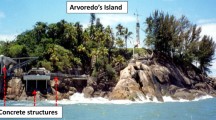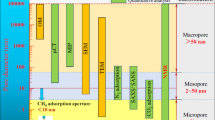Abstract
Ionic transport in concrete can be described using the formation factor, which is the ratio of the resistivity of the concrete and the pore solution resistivity. The pore solution resistivity may be assumed, directly measured, or computed from the pore solution composition. This paper describes an experimental investigation aimed at determining the feasibility of using X-ray fluorescence (XRF) to obtain the alkali concentrations of the pore solution which enable the calculation of pore solution resistivity. In order to do this, simulated pore solutions containing known amounts of sodium and potassium were prepared and analyzed using XRF. XRF was performed on two sample types: (1) the simulated solutions and (2) beads where the water from the solution is evaporated and the remaining material is fused using a fluxing agent. The compositions obtained experimentally from XRF are compared to known compositions to demonstrate the accuracy of the technique. In addition, the measured simulated pore solution resistivity was compared to the simulated pore solution resistivity calculated from XRF measurements. The results indicate that the composition had an average error of 0.50% while the estimated simulated pore solution resistivity had an average error of 10.95%. The results of this study indicate that XRF has the potential to be an alternative to the time consuming methods currently used to measure the composition of the pore solution.






Similar content being viewed by others
Notes
K-alpha is the emission line due to an electron transition from the L-shell to the K-shell; considered the strongest energy spectral line. K-beta is the emission line due to an electron transition from the M-shell to the K-shell.
References
Andersson, K., Allard, B., Bengtsson, M., Magnusson, B.: Chemical composition of cement pore solutions. Cem. Concr. Res. 19(3), 327–332 (1989)
Vollpracht, A., Lothenbach, B., Snellings, R., Haufe, J.: The pore solution of blended cements: a review. Mater. Struct. 49(8), 3341–3367 (2016)
Barneyback, R.S., Diamond, S.: Expression and analysis of pore fluids from hardened cement pastes and mortars. Cem. Concr. Res. 11(2), 279–285 (1981)
Hunkeler, F.: The resistivity of pore water solution—a decisive parameter of rebar corrosion and repair methods. Constr. Build. Mater. 10(5), 381–389 (1996)
Snyder, K.A.: Relationship between the formation factor and the diffusion coefficient of porous materials saturated with concentrated electrolytes: theoretical and experimental considerations. Concr. Sci. Eng. 3, 216–224 (2001)
Dullien, F.: Porous Media: Fluid Transport and Pore Structure. Academic Press, San Diego (1992)
Archie, G.E.: The electrical resistivity log as an aid in determining some reservoir characteristics. Soc. Pet. Eng. 146(1) (1942)
Christensen, B.J., Coverdale, T., Olson, R.A., Ford, S.J., Garboczi, E.J., Jennings, H.M., Mason, T.O.: Impedance spectroscopy of hydrating cement-based materials: measurement, interpretation, and application. J. Am. Ceram. Soc. 77(11), 2789–2804 (1994)
Li, W., Pour-Ghaz, M., Castro, J., Weiss, W.J.: Water absorption and critical degree of saturation relating to freeze-thaw damage in concrete pavement joints. J. Mater. Civ. Eng. 24(3), 299–307 (2012)
Layssi, H., Ghods, P., Alizadeh, A.R., Salehi, M.: Electrical resistivity of concrete. Concr. Int. 37(5), 41–46 (2015)
Elkey, W., Sellevold, E.: Electrical resistivity of concrete. Report No. 80, Norwegian Road Research Laboratory (1995)
Caruso, F., Mantellato, S., Palacios, M., Flatt, R.: ICP-OES method for the characterization of cement pore solutions and their modification by polycarboxylate-based superplasticizers. Cem. Concr. Res. 91, 52–60 (2016)
Lothenbach, B., Matschei, T., Moschner, G., Glasser, F.P.: Thermodynamic modelling of the effect of temperature on the hydration and porosity of Portland cement. Cem. Concr. Res. 38(1), 1–18 (2008)
Rajabipour, F., Sant, G., Weiss, W.J.: Interactions between shrinkage reducing admixtures (SRA) and cement paste’s pore solution. Cem. Concr. Res. 38(5), 606–615 (2008)
Taylor, H.F.W.: A method for predicting alkali ion concentrations in cement pore solutions. Adv. Cem. Res. 1(1), 5–16 (1987)
Snyder, K.A., Feng, X., Keen, B.D., Mason, T.O.: Estimating the electrical conductivity of cement paste pore solutions from OH−, K+ and Na+ concentrations. Cem. Concr. Res. 33(6), 793–798 (2003)
Bentz, D.: Virtual rapid chloride permeability test. Cem. Concr. Compos. 29(10), 723–731 (2007)
Castro, J., Spragg, R., Weiss, J.: Water absorption and electrical conductivity for internally cured mortars with a w/c between 0.30 and 0.45. J. Mater. Civ. Eng. 24(2), 222–231 (2012)
Spragg, R., Villani, C., Snyder, K., Bentz, D., Bullard, J.W., Weiss, J.: Factors that influence electrical resistivity measurements in cementitious systems. Transp. Res. Rec. J. Transp. Res. Board 2342, 90–98 (2013)
Bonta, M., Eitzenberger, A., Burtscher, S., Limbeck, A.: Quantification of chloride in concrete samples using LA-ICP-MS. Cem. Concr. Res. 86, 78–84 (2016)
Ngala, V.T., Page, C.L., Page, M.M.: Corrosion inhibitor systems for remedial treatment of reinforced concrete. Part 2: sodium monofluorophosphate. Corros. Sci. 45(7), 1523–1537 (2003)
Zanella, R., Primel, E.G., Martins, A.F.: Determination of chloride and sulfate in pore solutions of concrete by ion chromatography. J. Sep. Sci. 24(3), 230–231 (2001)
Capacho-Delgado, L., Manning, D.C.: The determination by atomic-absorption spectroscopy of several elements, including silicon, aluminum, and titanium, in cement. Analyst 92, 553–557 (1967)
Klockenkamper, R., von Bohlen, A.: Total-reflection X-ray fluorescence analysis and related methods, 2nd edn. Wiley, New York (2014)
Bouchard, M., Anzelmo, J., Rivard, S., Seyfarth, A., Arias, L., Behrens, K., Durali-Muller, S.: Global cement and raw materials fusion/XRF analytical solution. Int. Cent. Differ. Data 26(2), 263–279 (2010)
Alonso, C., Andrade, C., Castellote, M., Castro, P.: Chloride threshold values to depassivate reinforcing bars embedded in a standardized OPC mortar. Cem. Concr. Res. 30(7), 1047–1055 (2000)
Fontas, C., Margui, E., Hidalgo, M., Queralt, I.: Improvement approaches for the determination of Cr(VI), Cd(II), Pd(II) and Pt(IV) contained in aqueous samples by conventional XRF instrumentation. X-Ray Spectrom. 38(1), 9–17 (2008)
ASTM C114: Standard test methods for chemical analysis of hydraulic cement 1. ASTM International (2004)
Castro, J., Spragg, R.P., Compare, P., Weiss, W.J.: Portland cement concrete pavement permeability performance. Report FHWA/IN/JTRP-2010/29. Joint Transportation Research Program (2010)
Akerlof, G., Kegeles, G.: The density of aqueous solutions of sodium hydroxide. J. Am. Chem. Soc. 61(3), 1027–1032 (1939)
West, R.: CRC Handbook of Chemistry and Physics, 70th edn. CRC Press, Boca Raton (1989)
Wolf, A.V.: Aqueous Solutions and Body Fluids. Harper and Row, New York (1966)
AASHTO Designation: PP84-17. American Association of State Highway and Transportation Officials (2017, in press)
Luping, T., Lars-Olof, N.: Chloride binding capacity and binding isotherms of OPC pastes and mortars. Cem. Concr. Res. 23(2), 247–253 (1993)
Suraneni, P., Jafari Azad, V., Isgor, O.B., Weiss, W.J.: Deicing salts and durability of concrete pavement and joints. Concr. Int. 38(4), 48–54 (2016)
Julliand, P., Gallucci, E., Flatt, R., Scrivener, K.: Dissolution theorey applied to the indication period in alite hydration. Cem. Concr. Res. 40(6), 831–844 (2010)
Nicoleau, L., Schreiner, E., Nonat, A.: Ion-specific effects influencing the dissolution of tricalcium silicate. Cem. Concr. Res. 59, 118–138 (2014)
Suraneni, P., Flatt, R.: Use of micro-reactors to obtain new insights into the factors influencing tricalcium silicate dissolution. Cem. Concr. Res. 78(B), 208–215 (2015)
Leemann, A., Lothenbach, B., Thalmann, C.: Influence of superplasticizers on pore solution composition and on expansion of concrete due to alkali-silica reaction. Constr. Build. Mater. 25(1), 344–350 (2011)
Shehata, M.H., Thomas, M.D.A., Bleszynski, R.F.: The effects of fly ash composition on the chemistry of pore solution in hydrated cement pastes. Cem. Concr. Res. 29(12), 1915–1920 (1999)
Acknowledgements
The authors would like to acknowledge partial financial support from the Kiewit Transportation Institute and the Federal Highway Administration (FHWA) through DTFH61-12-H-00010. The authors appreciate the assistance of Stephen Williams and Terry Suscavage from PANalytical for their aid in setting up the XRF system. The authors also acknowledge the laboratory work performed by undergraduate research assistants Nathalene Then and Naomi Salgado. All of the laboratory work presented herein was performed at the Kiewit Transportation Institute at Oregon State University.
Author information
Authors and Affiliations
Corresponding author
Rights and permissions
About this article
Cite this article
Chang, M.T., Suraneni, P., Isgor, O.B. et al. Using X-ray fluorescence to assess the chemical composition and resistivity of simulated cementitious pore solutions. Int J Adv Eng Sci Appl Math 9, 136–143 (2017). https://doi.org/10.1007/s12572-017-0181-x
Published:
Issue Date:
DOI: https://doi.org/10.1007/s12572-017-0181-x




